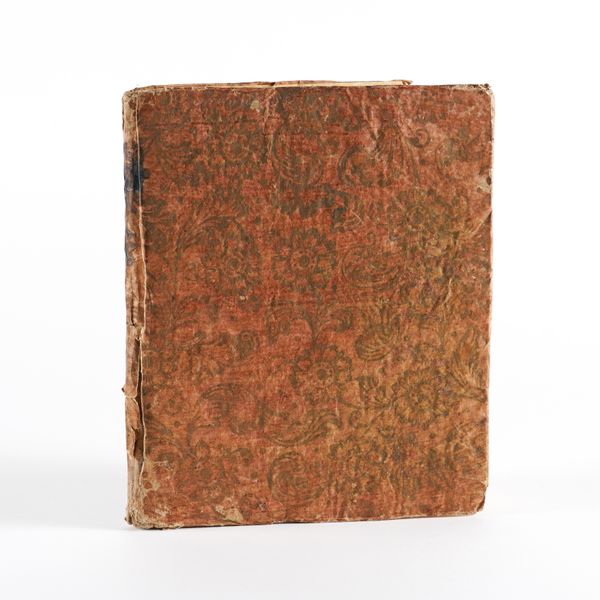AYRES, Ralph (fl.early-mid-18th-century). A fine manuscript recipe book on paper containing 69 recipes on 38 leaves, inscribed, "Radolphus Ayres, Cook, Oxford, 1722", boards. A MANUSCRIPT COMPILED IN 1722 BY THE HEAD COOK OF NEW COLLEGE, OXFORD. RARE.
| Estimate: | £2,000 - £3,000 |
| Hammer price: | £5,500 |
AYRES, Ralph ("Radolphus") (fl.early-mid-18th-century). A fine manuscript recipe book on paper containing 69 recipes on 38 leaves, most written on the rectos only, inscribed on the verso of the first leaf, "Radolphus Ayres, Cook, Oxford, 1722", many pages adorned with pen flourishes at the foot (short inconspicuous closed tear to first two leaves, without loss, some light spotting and staining, small hole in final leaf not affecting letters). Contemporary "Dutch" pale green-and-pink floral-pattern paper boards (some rubbing to extremities, the backstrip torn in places, a section of floral paper torn away from the foot of the backstrip and the lower wrapper, an old ink stain to the head of the spine), Oxford, small 4to (190 x 155mm), 1722. A FINE, PREVIOUSLY UNRECORDED, MANUSCRIPT, IN ORIGINAL CONDITION, OF RECIPES COMPILED BY THE HEAD COOK OF NEW COLLEGE, OXFORD. It is unusual to have such a manuscript dated precisely and even more unusual to know something of the person who compiled it. About seven other similar manuscripts inscribed "Radolphus Ayres" and dating from the first half of the 18th-century have been variously identified, although it is possible that some records of those not preserved in institutions have been duplicated as they have appeared in the trade. In light of the fine condition of the present manuscript and absence of old revisions, addenda and food-staining - a common fate of early cookery books - it seems likely that these copies were intended less for use as everyday "working" cookery books and, more likely, as gifts to friends or fellow cooks, in order to preserve the recipes for posterity. Ralph Ayres is recorded as being Head Cook at New College at various times in the 18th-century, with one recipe in the present manuscript referring specifically to the college ("new colledg puddings"). The first entry in the manuscript is unusual in being a "Receipt", or remedy, "... for ye shortness of Breath", but thereafter only recipes or food preservations are included: for example, "Mackrouns", "To make the Ice for the Cake", "To make Oxford Sausages", "To make Naples Bisket", "To pott pigeons or partridges", "To make a Dish of Scottch Collops", "To make a Good Beef Gravey", "To make London Wiggs [i.e. tea biscuits or cakes]", "To make a Quaking puding [so-called because, if properly prepared, it was meant to wobble]", "To make a dish of new Collidg puddings", "To make Ayres' his pancakes", "To make Cheescakes", "To preserve Damsons for tarts", "To make Ginger bread", "To make Ayres' his puding" and "To fricacie a Couple of Rabits or 3 larg Chickins". The last recipe in the manuscript, "To make Shrubb", is written in a different hand, and inscribed and dated, "[?]Transviglo [?]J. W. [indistinct third initial], 8 Sept 1751". Loosely-inserted on two separate paper slips are "To make Grape Wine" (not in the same hand) and "A Receipt to prevent too much sweating in a weak person" (in a different hand, but 18th-century). Two similar manuscripts, in near-identical floral-pattern bindings, are recorded in Oxford: one at the Bodleian (MS. Don. e. 89), dated 1721, and one in the archives of New College itself (NCA 962), dated 1719. The Bodleian record identifies a third from its reproduction in a book privately-printed in 1922 titled A Little Book of Recipes of New College Two Hundred Years Ago. The present location of this third manuscript is unknown but it cannot be ours since it was signed "Radolphus Ayres Cook of Newcolidg in Oxford 1721"; a further similar manuscript, inscribed "Radolphus Ayers [sic], Cook, 1715", was recently handled by Peter Harrington. In 2006, the Bodleian published Ralph Ayres' Cookery Book which contains a facsimile of their own manuscript, edited and with an introduction by Jane Jakeman in which she describes the elaborate traditions and cuisine of an Oxford college dining hall in the mid-18th-century, and more specifically of New College under Ralph Ayres: "It was a cuisine appropriate to the community it served, one which still conducted itself with some formality ... Dinner, usually served in Oxford between midday and 2 pm in the mid-eighteenth century, was the main meal of the day, at which dons were expected to wear white waistcoats, wigs and gowns ... At a dinner [at New College] in 1774 the first course included cod with oysters, ham, fowls, boiled beef, rabbits smothered with onion, mutton, veal chops, port griskins (lean part of the loin), New College Puddings, Mince Pies and roots (vegetables). In the second course were roast turkey, haunch of venison, a brace of woodcocks, snipes, veal olives, trifle, blancmange, stewed pippins and preserves quinces ... At supper, potted and salted meats, important recipes in Ayre's book, would have been consumed. The day might be rounded off with a snack, perhaps a hot pie or some small cakes, served with punch, an egg-flip or a negus of spiced wine and lemon, and at last the weary cooks could repose. Until breakfast, of course!" The book's foreword by David Vaisey, Bodley's librarian from 1986 to 1996, compares the text of the two Oxford copies and the third "lost" one: "The collection of recipes is substantially the same in all three manuscripts: the recipes occur in the same order, and two manuscripts (those from Bodley and from New College) are probably in the same handwriting". Both the handwriting and the order of the recipes in the present manuscript are almost identical to the two copies in Oxford, and its discovery can only shed further light on "Radolphus Ayres" who we can see - perhaps fancifully - as an 18th-century precursor of the modern "celebrity chef". RARE.















